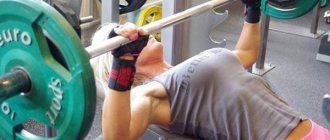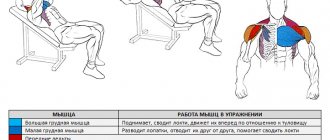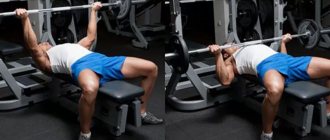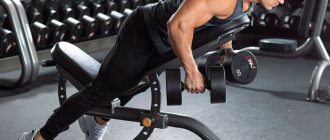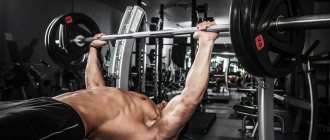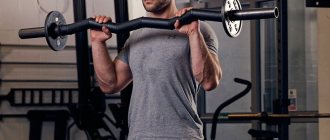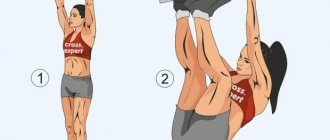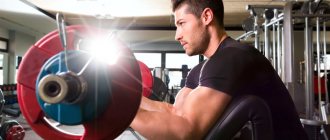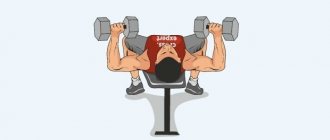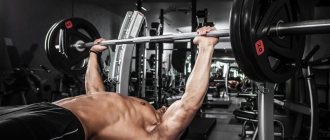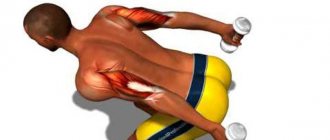A healthy lifestyle has become popular, many girls strive for an ideal figure by eating right and going to the gym. Most people do not pay enough attention to the chest muscles, and in vain. After all, the dumbbell bench press is just as important an exercise for girls as squats.
Don't miss the most popular article in the section: Body drying for girls. Training program, detailed nutrition menu for the month by day.
Dumbbell bench press for women: training goal
The dumbbell bench press is the basis of basic bodybuilding exercises. It is available in all gyms that have an incline bench and regular dumbbells. The main thing is to follow the correct execution technique so that the result appears.
Dumbbell bench press promotes ideal physical shape
When bench pressing with dumbbells, the following muscles are activated:
- pectoralis major muscle - it raises and reduces the elbows;
- the pectoralis minor muscle spreads the shoulder blades;
- the deltoid muscle provides movement of the upper arms;
- the triceps brachii helps straighten the elbow.
Not only working muscles play an important role, but also stabilizer muscles. These muscles do not directly assist in lifting dumbbells, but regulate the functioning of the core muscles.
Stabilizing muscles are:
- shoulder joint, rotator cuff muscles;
- lower part of the trapezius muscle;
- latissimus dorsi muscles.
They begin to practice exercises with the goal of working the pectoral muscles and increasing their performance. In everyday life, especially in girls, these muscles are little used and lose tone. To achieve aesthetic body proportions, it is important to master the dumbbell bench press technique.
Results appear after 1-2 months with regular training 2-3 times a week. If you don’t have time to visit the gym, some bench press exercises can be performed at home.
Inherent factors influencing the increase in the effect of training are:
- sleep pattern – it is important for muscle recovery after heavy physical exertion;
- proper nutrition - it is important not to starve, but to eat 5-6 times a day, but exclude fast carbohydrates and trans fats.
If these points are not followed, achieving results will be several times more difficult.
Practical application: which angle to choose?
The horizontal bench press is a recommended exercise for maintaining or improving dynamic upper body performance. To increase the performance of the anterior deltoid muscle, it is recommended to use a bench inclination greater than 45°.
High activation of the anterior deltoids during the bench press is a variable that should be considered when programming strength training.
Sources:
- Welsch, E. A.; Bird, M.; Mayhew, J. L. Electromyographic Activity of the Pectoralis Major and Anterior Deltoid Muscles During Three Upper-Body Lifts. J. Strength Cond. Res. 2005, 19, 449–452.
- Lauver, J. D.; Cayot, T. E.; Scheuermann, B.W. Influence of bench angle on upper extremity muscular activation during bench press exercise. Eur. J. Sport Sci. 2016, 16, 309–316.
- Saeterbakken, A.H.; Mo, D.-A.; Scott, S.; Andersen, V. The effects of bench press variations in competitive athletes on muscle activity and performance. J.Hum. Kinet. 2022, 57, 61–71.
- Glass, S.C.; Armstrong, T. Electromyographical activity of the pectoralis muscle during incline and decline bench presses. J. Strength Cond. Res. 1997, 11, 163–167.
- Barnett, C.; Kippers, V.; Turner, P. Effects of variations of the bench press exercise on the emg activity of five shoulder muscles. J. Strength Cond. Res.1995, 9, 222–227.
- Trebs, A.A.; Brandenburg, JP; Pitney, WA An electromyography analysis of 3 muscles surrounding the shoulder joint during the performance of a chest press exercise at several angles. J. Strength Cond. Res. 2010, 24, 1925–1930.
- David Rodríguez-Ridao, José A. Antequera-Vique, Isabel Martín-Fuentes, José M. Muyor. Effect of Five Bench Inclinations on the Electromyographic Activity of the Pectoralis Major, Anterior Deltoid, and Triceps Brachii during the Bench Press Exercise. Int J Environment Res Public Health. 2022 Oct 8;17(19):E7339.
How to use the bench angle correctly
In most cases, bench presses are performed in a horizontal position. Incline benches are often left empty, as the effect of performing the exercise on them is underestimated.
The dumbbell bench press appears to be something useless for girls, especially at an incline angle. But the incline of the bench allows you to more effectively work the pectoral muscles and use the rest.
There are several options for inclining the dumbbell bench press:
- Negative. In another way it is also called “reverse or head down”. This type of inclination is used to work the expressive lower part of the pectoral muscles. It is especially useful for girls, as it allows them to tighten their breasts and décolleté. Also, when performing the exercise with a negative incline, performance in the regular bench press improves. The correct technique allows you to remove significant stress from the shoulder joint.
- Positive. This angle of inclination engages the upper pectoralis major muscles, improving their balance and shape. Moreover, the positive incline bench press targets the pectoralis minor, triceps, and anterior deltoids, allowing you to strengthen multiple muscle groups at once.
It is important to alternate the dumbbell press on an incline bench with the classic bench press in a horizontal position to deeply work out the muscle group. If you perform the bench press only on a horizontal bench, then the indicators will increase more slowly, and the shape of the pectoral muscle will be a little flat. Also, a lot depends on the level of inclination, since both positive and negative angles can be adjusted.
Traffic safety
There is an opinion that the back should be pressed against the bench in the lumbar region. In fact, removing the natural lordosis of the lower back will do nothing in terms of safety. But a relaxed upper back is the cause of an athlete’s unstable position and injuries. In order for the athlete to perform the movement safely, the back should be tense and the shoulder blades not spread along the plane of the back. The movement should not be done on a relaxed back, but lumbar lordosis is an acceptable thing.
The second point is that the sneakers should not slide if the exercise is done with emphasis on the floor, and the legs should not move along the surface. Leg support should be trained in all presses, as it is the key to the correct starting position of the athlete on the bench.
The assistance of the insurer is mandatory. In fitness gyms, bench press racks are made in such a way that only a person of a certain height can safely remove the barbell themselves. People below 170 cm and above 186 cm usually have problems with this. Yes, and lifting a barbell from the racks is a skill; if it is not trained, after independently picking up the apparatus, the athlete remains lying on a relaxed back, with his shoulders rounded forward, which is unacceptable due to safety regulations.
The warm-up for the incline bench press is usually a classic press. Or the athlete performs an incline press with an upward incline to target the upper chest first. The only point is that the first approach should not be performed with a working weight. Typically, any approach is preceded by rotation of the shoulder joint, that is, exercises to rotate the shoulder outward and inward, and warming up the elbows and wrists. Some athletes are accustomed to doing one set of any movement on the back, for example, pull-ups, to feel the collection of the shoulder blades.
Important: high blood pressure in an athlete is a contraindication for performing this type of bench press. Avoid doing incline bench presses with the bench sloping downwards and if the athlete experiences dizziness when standing up
The exercise is not recommended if you are taking medications to nourish the blood vessels of the brain. Also contraindicated is injury to the muscles of the chest, triceps and shoulder, as well as shoulder, elbow joints and wrists.
Incline press at 30 degrees
The 30° incline press works the chest, triceps, and anterior deltoids.
Execution principle:
- In the initial position, you need to lie on a bench, pressing your lower back and buttocks tightly against it. The feet are firmly on the floor.
- As you inhale, lower the projectile until your forearms are parallel to the floor.
- As you exhale, the projectile rises to its original position.
It is important to follow several rules: do not allow the dumbbells to collide at the highest point, do not arch your lower back. The number of repetitions for girls is 10-15 if the weight of the apparatus is from 4 to 6 kg.
Execution technique
The technique for performing the exercise is as follows:
- The bench is installed at an angle of 45 degrees. You need to sit on it in such a way that you rest well on the back. Hold dumbbells in your hands with your palms facing inward.
- Inhale and exhale, and as you exhale, without jerking, raise your arm at the elbow. When the forearm is parallel to the floor, turn the palm with the dumbbell inward (towards the biceps).
- There is no need to bend your arm until the dumbbell touches your arm - just as when extending, you do not need to achieve a straight arm at the end of the movement.
- The elbows remain motionless during execution - do not bring them back or to the sides.
This exercise can be performed with both hands at the same time or alternately. If we take into account the opinion of professionals, then such work on the biceps is mandatory - that is, the incline bench press is one of the basic elements.
Press at a 40 degree angle
The dumbbell bench press for girls at an angle of 40° differs from the previous exercise in that the shoulder joints work more. If it is necessary to achieve development of the muscles of the shoulders and chest, you need to increase the inclination of the bench.
The principle of execution is the same as a bench press at an angle of 30°. It is not recommended to set the bench angle to more than 40°, since in this case only the shoulders will be involved.
Exercise options
The first thing you can vary is the angle of the bench. The larger it is (the closer the body is to the vertical), the more the deltas are involved in the work and the less the pectoral muscles. The optimal angle for pumping up the chest is 30 degrees, but some athletes set the bench to 45, which also has a positive effect on progress.
For lovers of variety and experienced athletes - a negative bias. It shifts the load to the lower chest. If you believe the professionals, you need to change exercises regularly. And the ability to change the angle in this case is to your advantage. You don’t radically change the program, but at the same time you pump up your muscles as much as possible, using a minimum of equipment.
Another option is the alternate arm press. This will help you focus on a specific muscle group and practice technique. Although in terms of progress, of course, this is not so effective, and hands can be developed differently.
Close grip press
When performing a bench press with a close grip, the triceps and triceps brachii muscles are mainly used.
Execution method:
- In the initial position, you need to lie on your back, your lower back pressed against the bench. The hands are positioned on the bar narrower than shoulder width.
- As you inhale, the barbell lowers to your chest; your elbows should not be moved far from your body.
- As you exhale, the projectile returns to its original position.
To achieve the best result it is important:
- do not straighten your elbows all the way at the highest point;
- lowering the barbell to the chest should be twice as slow as lifting it to the starting position;
- elbows move along the body.
Bench technique for burning fat
The dumbbell bench press for girls is a great way to reduce the percentage of body fat. While maintaining the execution methodology, several requirements are added.
The main ones:
- The nature of the training. To reduce adipose tissue, you can use pumping style or circuit training. Pumping involves pressing light weight dumbbells for the maximum number of repetitions (from 12 to 25). During circuit training, the dumbbell press is performed in several variations, but the exercises follow one after another, without interruption. At the end of the cycle, rest is no more than 3 minutes.
- Proper nutrition. Without maintaining the ratio of proteins, fats and carbohydrates 30/10/60, subcutaneous fat will not decrease.
What is important about the bench press technique for burning fat is that there is a large expenditure of energy, which the body draws from fat reserves.
When should it be included in a training program?
Generally, some people think that dumbbell exercises should be an afterthought. But that's not true. The dumbbell press is an even better alternative to the bench press.
Therefore, it is worth alternating dumbbells and barbells. This is how you can achieve maximum efficiency in shaping the upper pectoral muscles.
Here are a few training program options that you can use:
- At the beginning of training, as heavy pressing exercises. As an alternative to the barbell. And then perform isolated exercises.
- Perform after heavy bench presses with a barbell, as a finishing exercise for several approaches. And only then proceed to the isolated ones.
As practice shows, everything is individual. Some people prefer barbells, others use dumbbells. For some, forced repetitions, and for others, drop sets.
advertising is not displayed
You can find the right technique only by practicing different variations. Therefore, as soon as you stop progressing, you should immediately make adjustments.
Separately, it is worth noting the fact that the weight used in the exercise will in any case be less than using a barbell. But, work with dumbbells should be carried out in the style of high-volume training. That is, the main task is not to set a strength record, but to work out the muscle efficiently.
Press technique to increase muscle mass
The barbell or dumbbell press is often used by experienced athletes to gain muscle mass. In order for the exercise to achieve its goal, it is necessary to follow the generally established rules.
The basic rules include:
- the number of repetitions is reduced to a minimum, while the weight of the projectile is set to the maximum possible;
- increasing the number of approaches from 7 to 10;
- greater range of motion, the arms must cover a greater distance, then the muscles will be under maximum tension;
- the speed of movement should be low.
When all the rules are followed, the involved muscle fibers rupture and they begin to grow.
Don’t miss the most popular article in the section: Glutamic acid - what it is, why and how it is used in sports and bodybuilding.
Techniques for burning fat and increasing pectoral muscle mass
Many people set a goal to lose weight without losing muscle mass and the attractiveness of their body.
This can be done by following simple tips:
- The bench press technique should combine both high-repetition exercises and work with heavy weights. This load allows you to increase the mass of the pectoral muscles, while reducing the fat layer, since a large number of repetitions are performed using carbohydrates, and a small number - due to proteins.
- It is necessary to add aerobic exercises to strength exercises - walking, running, jumping rope.
- Basic strength exercises for various muscle groups cannot be ruled out; they help burn fat throughout the body.
An increase in muscle mass does not always entail a significant weight gain. With the right technique, you can combine muscle gain and weight loss.
Bench training programs
The dumbbell press is an upper body exercise and is used in conjunction with triceps exercises. The principle of creating a workout in this case: first – exercises for the larger muscle, in our case the pectoral muscle (press), then – an exercise for the triceps. This order allows you to work your muscles as efficiently as possible.
You can combine the press with biceps exercises and combine exercises for the large pushing muscle group with the pulling group.
The chest-back combination is no less popular. In this case, the antagonist muscles work: the chest is responsible for pressing, and the back is responsible for traction. This combination will work well for two large departments at once.
Splits save a lot of time and allow muscles to recover. This approach can be used by both beginners and professionals. By varying the weight of the equipment, you can change the purpose of the training - the more weight, the more strength training you do, the less weight with more repetitions - the more resilient your muscles will be.
Dumbbell fly
How to do it:
- in the initial position, you need to lie on a bench and press your lower back, arms with the apparatus bent at the elbows;
- the dumbbells are moved apart, while the angle at the elbow joint decreases as you inhale;
- As you exhale, the arms with the projectile return to their original position.
It is important when performing the exercise not to bend your elbows too much when spreading to the sides. It is also necessary to monitor the position of the lower back.
What muscles work
During the exercise, the main load falls on the muscles of the chest, especially the pectoralis major muscle. In addition, the movement involves the muscles of the abs, back, triceps and biceps. The deltoid muscles of the shoulders also work; the load on them depends on the value of the inclined angle.
Load on target muscles on a 10-point scale
| Chest - Upper | 8 (high) |
| Triceps | 5 (average) |
| Anterior delta | 5 (average) |
| Biceps | 1 (weak) |
| Abs and Forearms | 1 (weak) |
| Type of exercise | Power – Basic |
| Total load | 20 (average) |
Recommendations
- Pay attention to performing the exercise correctly. Don't try to increase the load. The weight of the dumbbells should be appropriate to your level of physical fitness.
- Control muscle tension. Avoid oscillating hand movements.
- Flatten your chest. Do not lift your shoulders and head off the bench. Watch the trajectory of your elbows to avoid injury.
- Breathe correctly. You will gain additional strength and endurance.
- At the top of the movement, maintain distance between sports equipment. Do not extend your arm completely to maintain the effectiveness of the exercise.
Dumbbell bench press with a narrow parallel grip
When pressing dumbbells with a narrow parallel grip, the muscles of the chest, back and triceps work.
Exercise method:
- in the starting position, the athlete lies down on the bench and presses his lower back tightly, turns his hands with the apparatus, palms facing each other, shoulder-width apart;
- while inhaling, the arms are lowered until an angle of 90° is formed with the forearm;
- As you exhale, the dumbbells are pushed out by the pectoral muscles, and the arms return to their original position.
Dumbbell bench press with supination and pronation
The dumbbell bench press with supination and pronation allows you to get all the benefits of the dumbbell exercise.
Order of exercises:
- When performing a press with supination, the starting position is maintained as with a regular bench press on a horizontal bench. When raising your arms while inhaling, you need to turn your palms towards each other. Rotation is accomplished not by the wrist, but by the elbow joint.
- When pressing dumbbells with pronation, everything is done the other way around: in the starting position, the palms face each other, and at the top point they face forward.
To achieve the best results, you need to bring your shoulder blades together and straighten your chest.
Contraindications
Do not perform this exercise if you have pain in the muscles and ligaments of your shoulders, elbows and wrists. You should not exercise if you have arthrosis or arthritis of the joints of the upper extremities. It is better not to use this type of training if there is instability in the shoulder and elbow joints that occurs after dislocations.
You should not exercise if you have high blood pressure or heart disease. It is better not to postpone training if you feel general weakness and increased body temperature. First, you need to undergo proper treatment and recovery, and only then begin full-fledged training.
Alternating Dumbbell Bench Press
This type of press can be performed on a straight bench or on an incline bench. The exercise allows you to maximally work out the left and right sides of the chest separately.
How to do the exercise:
- for the starting position, you need to lie on a bench and move your arms to the sides at an angle of 90°, elbows facing the floor;
- while inhaling, the right hand rises up;
- as you exhale, the right hand lowers to its original position;
- on the second inhalation, the same is done with the left hand;
- As you exhale, both arms return to their original position.
Dumbbell bench press for girls on a horizontal bench
The non-incline dumbbell bench press is a great way to build the strength and quality of your chest muscles.
How to do the exercise:
- in the starting position, you need to lie on a bench, tightly fixing your lower back, arms with the apparatus spread to the sides at a right angle, elbows directed towards the floor;
- while inhaling, a pushing movement is made and the dumbbells are brought together, but do not collide;
- when exhaling, you must return to the original position.
Main mistakes
Pay attention to the following mistakes and try to avoid them:
- If you choose too much weight, you will involuntarily jerk during exercise. The movement will be incorrect, it will be difficult to stabilize, and in the end you may simply not be able to support the weight.
- A very important nuance - during the exercise, try to move your elbows to the sides from the body at a right angle. That is, the right and left shoulders in the lower position form one straight line when viewed from above. When you press your elbows to your body, or keep them closer to your head, the meaning of the exercise is lost.
- Incorrect insurance. The problem is that most people don’t know how best to present dumbbells to an athlete lying upside down. So, he takes one dumbbell himself. Lays down on the original one, and then you give him the second one. Working at a positive angle of 45 or 30 degrees, a person will typically lift the dumbbells themselves.
- Sometimes the following mistake occurs: the head is raised, glances to the sides, and sometimes it is simply hanging the head over the edge of the bench. The head should fit snugly with the back of the head on the bench.
- An attempt to press dumbbells upside down without fixing the legs. You understand, this is fraught with your debut sliding down.
- The correct speed of movement is an important component of the success of any workout. We make smooth, slow, clear movements. Technology is the key to achieving the desired results.
Dumbbell bench press with a reverse, negative downward inclination
The negative incline dumbbell bench press is also called the reverse incline or downward incline press. This type of press works the lower chest and triceps.
Execution method:
- for the starting position, the bench is lowered down, you need to lie down so that your head is lower than your torso, your legs are placed under the fixing bolsters, your hands hold dumbbells shoulder-width apart;
- as you inhale, lower the dumbbells to the lower chest, do not move your elbows far from your body;
- as you exhale, return the projectile to shoulder width.
The dumbbell bench press with a negative incline is very useful for girls, as it helps tighten the breasts, give them elasticity and create aesthetic shapes.
Changing the inclination angle
This position differs from the horizontal position by a modified backrest tilt and movement of the dumbbells; the degree of the bench is set to 30-45 units.
The angle exercise is useful after the basic barbell exercise.
Changing the tilt is possible not only to the upper position, but also to the lower one. Here the angle is also set to 30-45 degrees.
Technically, all types of tasks are performed in the same way. However, there are nuances:
- When placed upside down, the position is unstable, so it is recommended to slightly raise the edge of the machine. To do this correctly comes with experience.
- Despite the change in angle, the dumbbell movements should remain in the vertical axis. Thanks to the correct technique, the loaded pectoral muscles change.
- When inclined, it is recommended to spread your legs wider, which will add stability.
- Particular attention should be paid to the technique when positioned upside down.
Due to this condition, blood rushes to the head, which affects intracranial pressure. In poor health, athletes feel dizzy and have dark vision. The exercise is absolutely not suitable for older people. Being upside down is not very convenient for picking up dumbbells, so you need to ask for help in advance.
| with your head tilted up | 10–15 times, 3-4 approaches |
| with head down | 10 times, 1 set |
| horizontal placement | 10-15 times, 3 sets |
| fitball placement | 15 times, 1 set |
For the result of the movement in an inclined state, a few working repetitions are enough, and it is necessary to work with a small weight. After finishing the press from a head down position, you need to get up slowly. Dizziness may occur with sudden movements.
Dumbbell bench press with positive incline
The positive incline dumbbell press involves lifting your torso up at a certain angle. The standard angle of an incline bench is 30-40°. It makes no sense to set a larger angle, since the load will transfer completely from the chest to the shoulders.
The dumbbell bench press with a positive incline is suitable for those who have experience with the classic press. A positive incline allows you to work the chest muscles, along with the triceps and deltoids.
How to do it:
- in the starting position, you need to lie on a bench with an incline, your feet pressed to the floor, your hands holding dumbbells shoulder-width apart;
- as you inhale, lower the dumbbells below the chest line, do not move your elbows far from the body;
- As you exhale, lower your arms again to shoulder width.
Advice from professionals: how to increase the effectiveness of your training
Many experienced athletes note that the effectiveness of training directly depends on how correctly the basic generally established rules of training are followed.
The rules are as follows:
- Execution technique. If the exercise is performed with technical errors, the result will be zero, since the muscles will not be correctly involved in the work. This is not only useless, but also unsafe. If the technique is incorrect, injuries and joint damage may occur. In order to supply the correct technique, it is advisable to use the services of a professional trainer at the initial stage.
- Regularity of training. It is important to follow a gym routine, since long breaks reduce the results to a minimum and you have to start all over again.
- Recovery. Excessive constant stress is just as harmful to the body as lack of activity. Training should end with recovery, that is, sleep for at least 8 hours. It is important to take breaks of no more than 3 days between workouts. It is recommended to take a two-week vacation every six months. For recovery, it is also important to eat right, include more protein and fiber in your diet, which promote muscle growth.
- Keeping an exercise diary. This technique promotes self-control and tracking progress in training. In the diary you can note your training calendar, strength indicators, duration of the session and weight.
The dumbbell bench press is an excellent way for girls to develop strength and endurance and increase the percentage of muscles in the body. The bench press also helps you lose weight or gain muscle mass, depending on the chosen technique.
Unpleasant moments
Yes, there are some unpleasant points that are worth paying attention to:
High probability of injury due to negligence. Since the weight of dumbbells can be large, even with perfect technique, errors can occur.
Still, we are human, and we can do something carelessly. But in this exercise, the slightest jerk of a dumbbell with a large weight to the side can lead to ligament rupture, tendon damage and other injuries. Such injuries take a long time to heal and interfere with training.
Inability to gradually increase weight. This problem will only affect very healthy guys who work with extreme weights. For example, you want to go from a weight of 45 kg to a slightly heavier weight, for example 47 kg. But you can conclude that you can’t do this, because there are no pancakes that would help you gain exactly that amount of weight. You have to hang 50 at once, which is a bit much.
It's time to move on to discussing the technique to avoid injuries and learn useful tricks.
